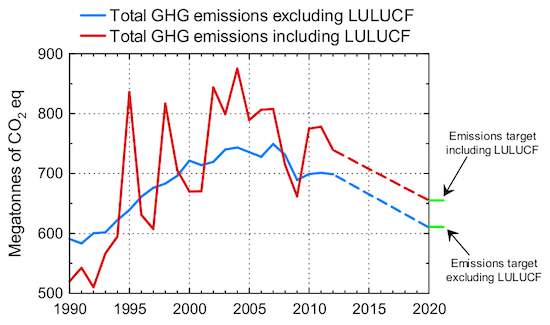By Sierra Rayne ——Bio and Archives--December 11, 2014
Global Warming-Energy-Environment | CFP Comments | Reader Friendly | Subscribe | Email Us

"The analysis indicates that, in a scenario where consumers, businesses and governments take no action to reduce emissions after 2005, emissions in 2020 will rise to 857 Mt. Under the 'with current measures' scenario that includes actions since 2005 as well as the contribution from LULUCF [Land Use, Land-use Change and Forestry], Canada's GHG emissions in 2020 are projected to be 727 Mt, a total of 130 Mt less than under a 'without measures' scenario. This highlights the significant expected impacts of actions made to date but also indicates the need for further efforts from all Canadians, as additional reductions of 116 Mt will be required to meet Canada's Copenhagen commitment. In a Spring 2012 submission to the United Nations Framework Convention on Climate Change (UNFCCC), Canada stated its intent to include the LULUCF sector in its accounting of GHG emissions towards its 2020 target, noting that emissions and related removals resulting from natural disturbances would be excluded from the accounting. It was also indicated at that time that a Reference Level or comparison against a 2005 baseline would be used for accounting. Based on these accounting approaches, the expected LULUCF contribution is 19 Mt, largely reflecting lower expected harvesting of trees in forest lands than in the past. This 19 Mt contribution is subtracted from total national emissions projections in 2020 as a credit towards reaching the target. Analysis of alternative accounting approaches remains ongoing."We can cut to the chase on all this: Environment Canada's GHG emissions report and projections are junk science. In the same time series, you simply cannot mix-and-match GHG emissions that include the LULUCF sector with those that exclude the LULUCF sector. They are different datasets that must be treated separately, especially when predicting future emissions and setting a regulatory limit (i.e., the now infamous Copenhagen target of a 17 percent emission reduction by 2020 compared with 2005 levels). See that lighter blue line that goes from 1990 to 2012 in the Environment Canada plot shown above, and which is widely reproduced in the media? That is Canada's total GHG emissions excluding the LULUCF sector. How do we know? Well, the report itself tells us so -- and the United Nations Framework Convention on Climate Change (UN-FCCC) Greenhouse Gas Inventory Database tells us the exact same thing. The Environment Canada data from the figure above and the UN-FCCC data for Canada's "Total GHG emissions excluding LULUCF" are exactly the same, as the figure below shows using the UN-FCCC data for Canada both "including" and "excluding" LULUCF.
 As the graph clearly shows, current and historical total GHG emissions for Canada are very different if you choose to include the LULUCF sector. If we exclude the LULUCF sector, Canada's GHG emissions in 2005 were 736 Mt, and a 17 percent reduction by 2020 requires emissions to decline to 611 Mt. The Environment Canada report even states this on page 2:
As the graph clearly shows, current and historical total GHG emissions for Canada are very different if you choose to include the LULUCF sector. If we exclude the LULUCF sector, Canada's GHG emissions in 2005 were 736 Mt, and a 17 percent reduction by 2020 requires emissions to decline to 611 Mt. The Environment Canada report even states this on page 2:
"Under the Copenhagen Accord, Canada committed to reducing its emissions by 17 percent from 2005 levels by 2020. As economy-wide emissions in 2005 were 736 Mt, Canada's implied Copenhagen target is 611 Mt in 2020."These are numbers that exclude LULUCF. But wait, on page 4 of Environment Canada's report there is a table which claims that Canada's GHG emissions "total with LULUCF contribution" in 2005 was 736 Mt, and in 2012 it was 699 Mt. Wrong. These are the totals without the LULUCF contribution, as Canada's own data in the UN-FCCC database clearly shows. Canada's GHG emissions "total with LULUCF contribution" in 2005 was -- in fact -- 789 Mt, not 736 Mt. This means that if we set a 2020 target of 17 percent below 2005 based on GHG emissions that include LULUCF, Canada's target is 655 Mt, not 611 Mt. As well, Canada's emissions "total with LULUCF contribution" in 2012 was 739 Mt, not 699 Mt as the Environment Canada report incorrectly claims. Errors of this magnitude should never appear in a government report of such importance to policy making endeavors, and they suggest a lack of appropriate ministerial oversight. Of course, the same GHG emission numbers on page 4 that are claimed to be "total with LULUCF contribution" are then presented on page 18 as "excluding LULUCF."
View Comments
Sierra Rayne holds a Ph.D. in Chemistry and writes regularly on environment, energy, and national security topics. He can be found on Twitter at @srayne_ca